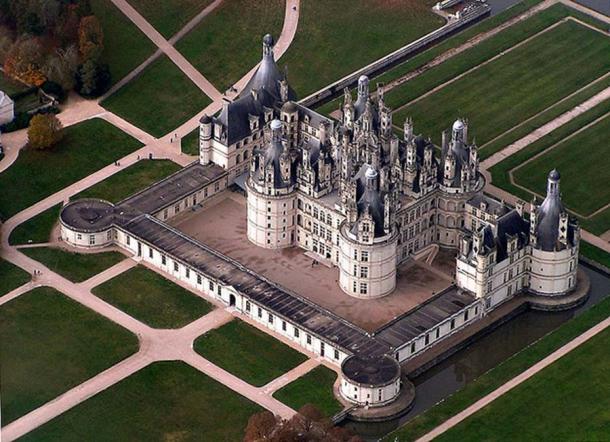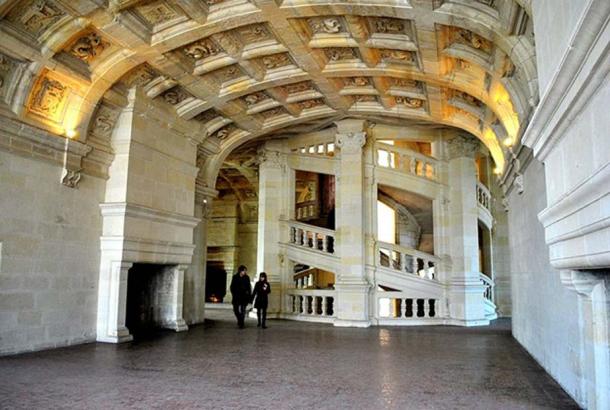One of the most impressive architectural features of the French Renaissance castle of Château de Chambord is its famous double helix staircase. The design of this element is popularly attributed to the renowned Italian Renaissance polymath, Leonardo da Vinci.
The Château de Chambord is a castle located in the Loire Valley, in the French department of Loir-et-Cher. The construction of the Château de Chambord began during the 16th century, and it is an archetype of the architectural style known as ‘French Renaissance’, which flourished between the 15th and 17th centuries in France.

Northwest façade of the Château de Chambord. (Benh Lieu Song/ CC BY SA 3.0 )
Commissioning the Château de Chambord
The building of the Château de Chambord was commissioned in 1519 by Francis I, the King of France. Initially, the castle was meant to serve as the king’s hunting lodge, where he would stay for several weeks during each visit, and hence was not designed to serve as a permanent residence.
Nevertheless, Francis was a great lover of the arts and the Château de Chambord, in spite of being a temporary residence, was elevated to the status of an architectural marvel. Francis’ pride in the Château de Chambord is evident, as he showed it off to visiting sovereigns and ambassadors, including his great nemesis, the Holy Roman Emperor, Charles V, who visited the castle in 1539.
Between the commencement of the castle’s construction until the death of Francis in 1547 (about 28 years), the king is believed to have only spent 72 days at the Château de Chambord. At the time of the king’s death, only the keep and the royal wing had been completed.
But the death of Francis did not halt the construction of the Château de Chambord. Work on the castle continued during the reign of Henry II, the successor of Francis. It was, however, only during the 17th century, when France was under the rule of Louis XIV, that the Château de Chambord was finally completed.

Birdseye view of the château de Chambord, France. ( CC BY SA 3.0 )
The Château de Chambord Double Helix Staircase
The Château de Chambord is significant from an architectural point of view for a number of reasons. For example, it is today the largest Renaissance castle in the Loire Valley. Additionally, this castle is regarded to be one of the best examples of French Renaissance architecture, a style that succeeded Gothic architecture, and in turn was succeeded by Baroque architecture. The Château de Chambord’s best-known architectural feature, however, is its double helix staircase.
In essence, this staircase consists of two intertwining spiral staircases that go all the way up to the castle’s terrace. In practical terms, this design would allow visitors to the castle to ascend and descend without obstruction. One staircase may be used by those going up, whilst the other by those going down, and the two parties would not bump into each other. In addition, this was the place where the French royal court stood when they welcomed important guests to the castle or when they watched the festivities.

The double helix staircase of the Château de Chambord. (Ignaz Wiradi/ CC BY SA 3.0 )
Leonardo Da Vinci Designed a Staircase
One of the most often cited trivia about the double helix staircase in the Château de Chambord is that it was designed by the great Renaissance polymath, Leonardo da Vinci, himself. It is known that in 1516, Leonardo da Vinci entered into the service of Francis and settled in the Château du Clos Lucé, another castle in the Loire Valley.
The great polymath would live there until his death in 1519. With such a brilliant mind living in the vicinity, it is not too difficult to imagine that this ingenious staircase was designed by Leonardo da Vinci. Some have even suggested that Leonardo da Vinci was responsible for the original design of the castle as well. At the very least, there is some agreement that Leonardo da Vinci influenced the design of the castle’s double helix staircase.

Portrait of Leonardo da Vinci by Francesco Melzi. ( Public Domain )
Today, the Château de Chambord is a popular tourist destination and its double helix staircase is undoubtedly one of the highlights. It is almost certain that visitors seeing this staircase today would be awed by it in a similar manner as those fortunate enough to see it when the castle was owned by the kings of France.
Top Image: The double helix staircase of the Château de Chambord. Source: Helac/ CC BY 1.0
By Wu Mingren
Updated on January 12, 2022.
 RSS Feed
RSS Feed















 January 14th, 2022
January 14th, 2022  Awake Goy
Awake Goy  Posted in
Posted in  Tags:
Tags: 













